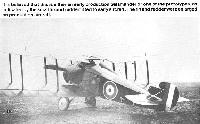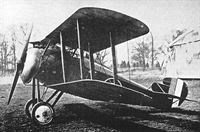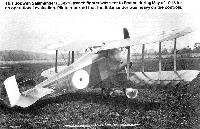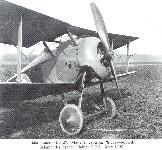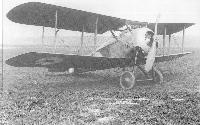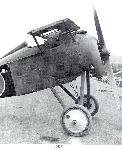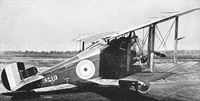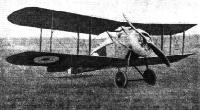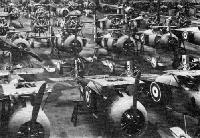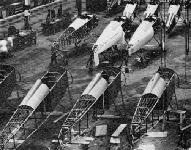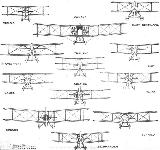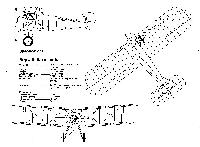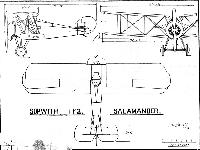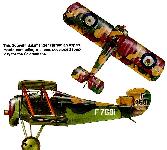В.Обухович, А.Никифоров Самолеты Первой Мировой войны
К завершающему периоду войны была продемонстрирована эффективность штурмовых атак самолетов на передовые позиции противника, особенно в наступлении. Поэтому сразу несколько британских компаний приступили к разработке самолета-штурмовика. Сопвич предложил штурмовой вариант истребителя "Кэмел" TF.1. Однако по результатам его испытаний было решено создать штурмовой вариант на основе "Снайпа". Новый самолет получил наименование TF.2 "Саламандер" ("Trench Fighter" - "траншейный истребитель"),
В передней части фюзеляжа был установлен бронированный короб, в котором помещались кабина пилота и топливный бак. К коробу крепились лонжероны нижнего крыла и стойки кабана верхнего, а также лонжероны фермы фюзеляжа. На серийных машинах иногда из-за перекоса короба нарушалась симметрия планера. Вооружение должно было состоять из двух пулеметов, установленных под углом вниз, и одного синхронного перед кабиной. Однако в серии оставили обычное вооружение - два синхронных пулемета перед кабиной пилота. Запас патронов был увеличен до 1000 на каждый пулемет. TF.2 оснащался двигателем Бентли B.R.2, который закрывался капотом с большим нижним вырезом. Из-за этого выреза капот вибрировал в полете и его пришлось подкрепить стальным подкосом к фюзеляжу.
Всего было произведено 526 самолетов, однако в боевых действиях они практически не участвовали. Отдельные образцы испытывались в США и Франции. Был создан палубный вариант самолета с водной лыжей перед колесами.
По конструкции TF.2 "Саламандер" представлял собой в основном деревянный двухстоечный биплан. Кабина пилота и бензобак были заключены в бронекороб, заголовник кабины также бронировался. Лонжерон стабилизатора был выполнен из алюминия. Устанавливались элероны как с роговой компенсацией, так и без.
Двигатель 1 х "Бентли" B.R.2 230 л. с.
Размеры:
размах х длина х высота 9,50 х 5,95 х 2,80 м
Вес
пустого 836 кг
взлетный 1139 кг
Максимальная скорость 200 км/час
Потолок 4000 м
Продолжительность полета 2 ч
Вооружение:
стрелковое 2 синхронных пулемета "Виккерс"
Экипаж 1 чел.
H.King Sopwith Aircraft 1912-1920 (Putnam)
T.F.2. Salamander
The fact that this present chapter - dealing with Sopwith's second type of armoured single-seat 'trench fighter' - is quite distantly removed in the book from that on the Camel T.F.1 (so that this Camel variant could be grouped with others of the same basic type) calls for repetition of one sentence from the T.F.1 account in order to establish a time-scale. Thus:
'On 7 March, 1918, the T.F.1 was flown to France, though its visit was apparently brief - possibly because the Salamander was already far advanced.'
This information we may now expand by noting that it was only in January 1918 that Sopwith had been asked to design the highly specialised Snipe-related machine which bore the designation T.F.2 - an appropriate one not only because this was a later design in the Sopwith series (the T.F.1 having been an interim or stop-gap type, possibly offering alluring prospects of ready conversions from the F.1 design) but more especially because the Snipe-related, instead of Camel-related, machine was intended to comply with British Expeditionary Force Specification No.2 (though for that matter, so had the T.F.1, handicapped though it was by lower power).
By the end of the month in which the above-mentioned request was made - January 1918 - the first of three T.F.2 airframes (E5429-E5431) was being erected. On 26 April it was sent to Brooklands, and on the very next day was first flown the T.F.1 Camel having first been airborne at Brooklands only on the preceding 15 February. By the time the T.F.2 had flown the name Salamander had been officially recognized - and never was an aeroplane named more fittingly.
The three factors most vitally affecting the specialised aspects of design and employment (apart from the Salamander's overall compatibility with the Snipe) were engine, armament and armour. Respecting the engine, an air-cooled rotary (Bentley B.R.2, though the eleven-cylinder Clerget 11E was considered as an alternative) was preferred to a water-cooled inline type, not only by reason of its reduced vulnerability to return fire from the ground but because by its very form it constituted a protective metal shield (the merits of such protection still being acclaimed for RAF radial-engined fighters between the wars).
As for armament, although it was at first intended to have one fixed synchronised forward-firing Vickers gun only (or a Lewis gun having a restricted arc of fire as had the top-wing gun on the T.F.1 Camel) in addition to two downward-firing Lewis guns through the floor (a la T.F.1, except that they would be adjustable in depression over a range of 35-55 degrees) the ultimate, and firmly-favoured, scheme was twin fixed forward-firing synchronised Vickers guns only.
Armour protection for the pilot and petrol tanks was a pre-eminent feature of design; no longer was 'a bit of armour underneath or an armoured bucket seat' sufficient - so the entire front fuselage was made as a box composed of armour plate (sufficient plates being ordered from Firths, in fact, for six machines, though three only were initially built). The box made up of armour plate was of these thicknesses: front (forming engine back-plate) 8 mm - the engine itself giving added protection, as already noted; bottom 11 mm.; sides 6 mm.; back 10-gauge sheet with 6-gauge close behind it. The pilot's head-fairing (not fitted on the Snipe) was also armoured, the frontal armour of this portion being in continuation of the forward of the two back-plates.
As flown at Brooklands on 27 April, 1918, Salamander E5429 had Snipe mainplane panels (in essence if not in detail) though the tailplane differed from the Snipe's in having an all-duralumin front spar. This metal spar has more than a passing interest, for during 1918 it was suggested at least once that three happenings only would bring down a Salamander - a direct hit by A. A. fire, the shooting-away of two flying wires or severe damage to a main spar. Prominent external differences were the flat-sided fuselage; early-type vertical tail-surfaces, as at first fitted to Snipe B9966 - that is, with slightly bigger rudder than formerly, but still with the horn-balanced part unshielded; differences in aileron rigging (the ailerons, in any case, being aerodynamically unbalanced, as on the early Snipes) - and unstaggered guns (staggered guns being a distinctive feature of production Salamanders).
To France for Service test went E5429 on 9 May, 1918; and on 30 June E5431 was tested at Martlesham Heath. Flight-reports were generally favourable, though aileron control was judged to be heavy. On E5431, at some stage, the guns were staggered (port gun a few inches behind starboard) the reason for this arrangement apparently being connected with the need to carry 1.000 rounds (earlier 750 rounds) for each gun. Thus, all things taken into account a fully equipped Salamander weighed about 500 lb (227 kg) more than a comparable Snipe. (A point to make in this regard is that although potential bomb load was 4 x 20 lb or 1 x 112 1b, this was not considered in any sense as primary armament - except, perhaps, for 'special' attacks, as envisaged for Naval units and as pioneered by Camels).
Although it might be supposed that, being called upon to operate at low level and high power, the Salamander would have a larger fuel capacity than the Snipe Mk.I, the reverse was the case - weight being a prime consideration, though the quantity of petrol actually carried varied. Moreover, the Salamander's petrol-delivery system and piping layout differed from the Snipe's. In addition to the Badin vacuum-feed system, the venturi for which was on the front starboard centre-section strut of the Salamander (as on contemporary Snipes) there was a Weyman hand-operated pump for stand-by use and protected by armour. The fifth instruction in Manufacturers' Order of Erection was, in fact: 'Fit Main Petrol Tank and connect up piping as far as V.P. cock and first rubber joints in pipe from Weyman pump at bottom of Main Tank.' A gravity tank was fitted close behind the engine.
In the dive the Salamander's speed accumulated quickly. Gliding angle was steep, and heavy landings led to landing-gear strengthening. Nevertheless, the opinions of some pilots were manifestly over-critical or ignored the aircraft's unique character, for its armour gave adequate protection against German armour-piercing bullets fired from short range. Rigging presented problems of its own, and in January 1919 it was formally notified that the machine was in rigging position when the thrust line which was scribed on the armour plate 'immediately aft of the side cowl on the port and starboard sides' - was level longitudinally and the fuselage was 'also level transversely'.
By this time, it was also made clear, the Salamander's tailplane was braced not by wires, as initially, but by 'four adjustable streamlined steel tubes', two above and two below. By means of these tubes the tailplane was to be adjusted until level transversely and until the incidence was correct (2 deg on the centre line).
The bottom wings were attached to 'fuselage housings' on the armour plate by means of a 'joint rod' and the rear end of the fuselage was attached 'by means of the four bolts through the joint box'. Other points of interest were that in truing-up the wings it was advisable first to adjust the upper wings until the dihedral was correct, and afterwards to adjust for stagger. It would then be found that any inaccuracy would be confined to the first bay from the fuselage on the lower wings. Such inaccuracy would occur at the lower-spar housings on the armour plate, and would be due to the 'very considerable' amount of distortion inherent in these plates, caused by the hardening process.
Clearly, the Salamander was a 'difficult' aeroplane from everyone's viewpoint - designer, constructor, pilot and rigger especially; though the difficulties must in the main have been foreseen when it was ordered into production (by the early summer of 1918). As production proceeded the type acquired the 'production-Snipe' fin-and-rudder assembly as well as the Snipe's horn-balanced top ailerons; though the slab-sided fuselage, prominent headrest, staggered guns and fixed tailplane still gave it visual distinction not to mention the camouflage that was applied in more than one scheme, was administered 'on the line' after October 1918, and was to be seen in Egypt as late as 1922.
Production continued after the Armistice (at Sopwith's own Ham works until the summer of 1919) - totalling nearer 300 than 200, and, as far as can be discovered, every Salamander built having the B.R.2 engine. Nevertheless, Salamanders never equipped a squadron, although many were stored, and the type was not unfamiliar at RAF stations.
One example, F6533, went to the USA. But although some of its postwar history is cloudy, the Salamander was never strong in private-owner appeal in the post-Armistice years at least, though the same would hardly be true today!
Production orders for Salamanders were:
Sopwith E5429-E5431; F6501-F7000 (not all of main batch delivered, but F6602, with strut-braced tailplane and horn-balanced top ailerons, was photographed on 25 January, 1919, and F6660 was at Farnborough in November of the same year).
N.B. A few in the range J5892-J5991 were completed by Glendower Aircraft Co Ltd, but large Salamander orders placed with the Air Navigation Co Ltd, National Aircraft Factory No.1, Palladium Autocars Ltd and Wolseley Motors Ltd were cancelled or curtailed by reason of the Armistice.
T.F.2 Salamander (230 hp Bentley B.R.2)
Span (over horn-balanced ailerons) 31 ft 2§ in (9.5 m); length 19 ft 6 in (5.9 m). Empty weight 1.844 lb (835 kg); maximum weight 2,512 lb (1,139 kg). Maximum speed at 3,000 ft (915 m) 125 mph (201 km/h); maximum speed at 6,500 ft (1,980 m) 123 mph (198 km h); maximum speed at 10,000 ft (3,050 m) 117 mph (188 km/h): climb to 6.500 ft (1.980 m) 9 min 6 sec: climb to 10,000 ft (3,050 m) 17 min 5 sec; service ceiling 13,000 ft (3,960 m).
N.B. Having regard to the Salamander's greater weight, largely attributable to its armour, it is of special interest to note that at 10.000 ft (3,050 m) the rate of climb had fallen off to about 330 ft/min (100 m/min) only, whereas the Snipe would still be climbing at about 700 ft/min (210 m/min).
P.Lewis The British Fighter since 1912 (Putnam)
The busy Sopwith factory proceeded to produce in the Spring of 1918 another single-seat two-bay biplane fighter - the T.F.2 Salamander - with the emphasis on trench strafing. In appearance closely resembling the Snipe, the whole fore-section of the fuselage was protected by armour plating. The Salamander’s engine was the 230 h.p. Bentley B.R.2, standard armament being a pair of nose-mounted Vickers guns. Experimental installations were tested consisting of batteries of multiple machine-guns, even to the extent of equipping one Salamander with eight guns concentrated to fire downwards through the bottom of the fuselage. The Salamander went into production but was too late to become operational before the Armistice and its very nature nullified use in the R.A.F. after the War.
F.Mason The British Fighter since 1912 (Putnam)
Sopwith T.F.2 Salamander
The early formative years of British military aviation were spent largely in developing the aeroplane as a battlefield support element, that is to say a vehicle for reconnaissance over the Western Front in France. It is true that the RNAS contrived some outstanding bombing operations in those early years, sometimes achieving results out of all proportion to the efforts expended, what would in later years be termed strategic operations. In the mid-War years the aeroplane came to be used as a weapon against enemy forces in the field: fighting scouts would be armed with a gun or guns as well as light bombs, yet retain their ability to defend themselves on equal terms against enemy fighters. Such an aeroplane was the F.1 Camel.
The Camel also came to be developed into what was known as a ‘trench fighter’, an aircraft whose principal role was to attack battlefield targets, and which carried armour protection against small arms fire from the ground.
That the T.F.1 Camel was regarded as no more than an interim expedient is, however, emphasised by the fact that, when the first example was sent to France for operational trials on 7 March 1918, a purpose-designed trench fighter, the T.F.2 Salamander, was already coming into being.
In January that year Sopwith had been asked to produce an aircraft to meet BEF Specification No 2, with performance superior to that of the T.F.1 Camel. It was therefore not unnatural that the new aircraft would be related to the Snipe rather than the Camel, and this is borne out by the speed with which new prototypes were built. Assembly of the first three of six prototypes (E5429-E5434) began at the end of January; the first was delivered to Brooklands for final assembly on 26 April, made its maiden flight the next day, and was flown to France on 9 May for operational trials - by which time three other prototypes had been flown. At the end of June, when the third aircraft, E5431, underwent Service evaluation, an order for 500 aircraft was placed with Sopwith; later orders for 600 Salamanders, placed with other manufacturers were either reduced or cancelled at the end of the War.
Like the Snipe, the Salamander was powered by a 230hp Bentley B.R.2 rotary and featured two-bay wings. The same plain ailerons and small tail surfaces as those on early Snipes were fitted, although these underwent modifications in step with the Snipe. Unlike the Snipe, however, the Salamander featured a flat-sided fuselage, while the entire front fuselage was constructed in armour plate, weighing no less than 650 pounds. Armament remained the nose-mounted pair of Vickers guns, but with ammunition increased from 1,500 to 2,000 rounds. (Various other armament schemes were flown experimentally, and at least one Salamander was armed with a battery of eight Lewis guns, all mounted to fire downwards.)
Production of Salamanders was accelerating rapidly when the Armistice was signed, but only two were in France at that time. One of these had been delivered to No 86 Squadron at Phalempin, a squadron that had been declared a ‘trench fighting unit’; a week later this order was rescinded. Two other Squadrons in England, Nos 95 at Wyton and 157 at Upper Heyford, had also been declared as ground attack squadrons, and between them took five Salamanders on charge before further deliveries were suspended.
A total of 210 Salamanders had been delivered into storage when production at Sopwith and Glendower was halted in 1919. One production aircraft, F6533, was sent to the United States for evaluation at McCook Field.
Type: Single-engine, single-seat, two-bay biplane trench fighter.
Manufacturers: The Sopwith Aviation Co Ltd, Kingston-upon-Thames, Surrey; The Glendower Aircraft Co Ltd, London.
Specification: British Expeditionary Force Specification No 2 of 1917.
Powerplant: One 230hp Bentley B.R.2 rotary engine driving two-blade propeller.
Dimensions: (Production) Span, 31ft 2 5/8 in; length, 19ft 6in; height, 9ft 4in; wing area, 272 sq. ft.
Weights: (Production) Tare, 1,844lb; all-up, 2,512lb.
Performance: (Production) Max speed, 125 mph at sea level; climb to 10,000ft, 17 min 5 sec; service ceiling, 13,000ft; endurance, 1 1/2 hr.
Armament: Standard armament was two synchronized 0.303in Vickers machine guns on nose with 1,000 rounds per gun.
Prototype: Six, E5429-E5434 (E5429 was first flown on 27 April 1918)
Production: Total of 1,100 Salamanders ordered. (Sopwith, 500, F6501-F7000; Glendower, 100: J5892-J5991; Palladium Autocars, 100: J5992-J6091; No 3 National Aircraft Factory, 400: J6092-J6491). Only 210 aircraft were completed (Sopwith, 160: F6501-F6660; Glendower, 50: J5892-J5941); remainder cancelled.
Summary of Service: Salamanders were delivered to No 86 Squadron in France, and to Nos 95 and 157 Squadrons in the United Kingdom, but these units did not become operational on them.
W.Green, G.Swanborough The Complete Book of Fighters
SOPWITH T.F.2 SALAMANDER UK
A requirement for an armoured single-seat ground attack fighter was issued to the Sopwith company in January 1918, a standard F.1 Camel being rapidly fitted with armour protection and triple-gun armament, and flying as the T.F.1 in the following month (T.F. indicating Trench Fighter). The T.F.1 was a stop-gap type that could be made available rapidly by modifying existing aircraft, but the requirement had specified the use of a 230 hp Bentley B.R.2 nine-cylinder rotary engine and Sopwith discarded the T.F.1 in favour of a modified Snipe design as the T.F.2 Salamander. Despite many similarities to the Snipe, the Salamander differed extensively and there was little or no interchangeability between the two aircraft. The forward portion of the fuselage was a simple armoured box, the bottom being 11-mm plate, the sides 6-mm plate, the front - the engine backplate - 8-mm plate and the rear 10-mm plate with a second 6-mm plate separated by 3.75 in (9,50 cm). Armament comprised two synchronised 0.303-in (7,7-mm) guns with provision for four 25-lb (11,34-kg) bombs. The first of three prototypes was flown on 27 April 1918, and the Salamander was ordered in large numbers (contracts were placed with the parent company, Air Navigation Co, Glendower Aircraft, National Aircraft, Palladium Autocars and Wolseley Motors), 37 being on RAF charge by 31 October. When hostilities ceased, production of the Salamander continued with a view to its use by the postwar RAF, and by mid 1919, when manufacture eventually terminated, Sopwith had delivered 334 and other contractors had contributed a further 85. However, no squadron was ever equipped with this type which was abandoned in favour of the Snipe.
Max speed, 125 mph (201 km/h) at 3,000 ft (915 m).
Time to 5,000 ft (1525 m), 6.5 min.
Endurance, 1.5 hrs.
Empty weight, 1,844 lb (836 kg).
Loaded weight, 2,512 lb (1139 kg).
Span (balanced upper ailerons), 31ft 2 6/8 in (9,52 m).
Length, 19 ft 6 in (5,94 m).
Height, 9 ft 4 in (2,84 m).
Wing area, 272 sqft (25,27 m2).
J.Bruce British Aeroplanes 1914-1918 (Putnam)
Sopwith T.F.2 Salamander
THE experiments with the Sopwith T.F.1 version of the Camel had successfully proved the feasibility of building an armoured single-seater for ground-attack work. The nature of the trench warfare of the period demanded ground-attack aircraft which would provide a relatively accurate yet flexible means of bringing machine-guns to bear on ground targets in the face of heavy defensive fire. The Sopwith aeroplane which was passed out by the Sopwith experimental department on April 26th, 1918, promised to perform that hazardous duty efficiently.
The new machine was the T.F.2 Salamander, an equal-span two-bay biplane which was clearly developed from the Snipe. The same engine, the B.R.2, was employed; and in general appearance the two aircraft were similar. The Salamander could be most easily distinguished by its flat-sided fuselage, the longer front legs of the undercarriage vees, and the head-rest behind the cockpit.
The entire forward portion of the fuselage was constructed of armour-plate which weighed no less than 650 lb, and formed an armoured container for the pilot and fuel tanks. To this box-like structure the longerons were attached. There were fairings on either side behind the circular engine cowling, and a rounded top-decking was fitted.
The prototype Salamanders had plain ailerons of the same length as those of the two-bay Snipe, and a similar vertical tail-assembly was fitted. The first prototype, E.5429, had single control horns on the ailerons, but E.5431 had two control horns on each aileron and two cables connecting upper and lower surfaces. In May, 1918, E.5429 was sent to France for Service trials, and it was not long before the Salamander was ordered into production.
The production Salamanders had ailerons of longer span than those of the prototypes; whilst the fin and rudder were increased in area and so modified in outline that they resembled those fitted to production Snipes. Plain ailerons and the small fin were fitted to the early production Salamanders, but when horn-balanced upper ailerons were introduced for the Snipe the corresponding surfaces of the Salamander were similarly modified, and the larger fin was also fitted.
The standard armament consisted of two fixed Vickers machine-guns firing forward through the airscrew: two thousand rounds of ammunition were carried. Experimental multiple-gun installations were made: one Salamander was fitted with a battery of eight guns, all of which fired downwards through the floor of the fuselage.
Salamander production was gaining momentum when the Armistice was signed, but only a few machines had reached France by that time. The majority of the machines in existence had not progressed beyond the Aircraft Acceptance Park. Production was continued into the summer of 1919, but the Salamander found no place in the peace-time R.A.F.
SPECIFICATION
Manufacturers: The Sopwith Aviation Company, Ltd., Canbury Park Road, Kingston-on-Thames.
Power: 230 h.p. Bentley B.R.2.
Dimensions: Span: prototype, 30 ft 1 1/2 in.; production, upper 31 ft 2 5/8 in., lower 30 ft 1 1/2 in. Length: prototype, 18 ft 9 in.; production, 19 ft 6 in. Height: 9 ft 4 in. Chord: 5 ft. Gap: 4 ft 3 in. Stagger: 1 ft 5 in. Dihedral: 4°. Incidence: 1° 50'. Span of tail: 9 ft 2 in.
Areas: Wings: prototype, 266-5 sq ft; production, 272 sq ft. Ailerons: prototype, each 10 sq ft; total 40 sq ft. Production, each upper 14 sq ft; each lower 11-5 sq ft; total 51 sq ft. Tailplane: 15 sq ft. Elevators: 11 sq ft. Fin (production): 2-75 sq ft. Rudder (production): 9 sq ft.
Weights and Performance: No. of Trial Report: M.211. Date of Trial Report: June, 1918. Type of airscrew used on trial: Lang 5300. Weight empty: 1,844 lb. Military load: 230 lb. Pilot: 180 lb. Fuel and oil: 258 lb. Total: 2,512 lb. Maximum speed at 500 ft: 125 m.p.h.; at 6,500 ft: 123-5 m.p.h.; at 10,000 ft: 117 m.p.h. Climb to 6,500 ft: 9 min 5 sec; to 10,000 ft: 17 min 5 sec. Service ceiling: 13,000 ft. Endurance: 1 1/2 hours.
Tankage: Petrol: 29 gallons.
Armament: Two fixed, forward-firing Vickers machine-guns mounted above and behind the engine, synchronised to fire through the airscrew; 2,000 rounds of ammunition were carried for these guns. Experimental installations of multiple machine-guns were made.
Production and Allocation: On October 31st, 1918, the R.A.F. had thirty-seven Salamanders on charge. Of these, only two were in France. In the United Kingdom, one was at an experimental station; one was with a squadron mobilising; one at another Home Establishment unit; one in store; and thirty-one were at Aircraft Acceptance Parks or with contractors. During 1918 a total of three had been sent to France and two to training units.
Serial Numbers: E.5429-E.5434: prototypes built by Sopwith. Production Salamanders were numbered between and about F.6526 and F.6602.
Costs:
Airframe without engine, instruments and guns £1,138
B.R.2 engine £880
H.King Armament of British Aircraft (Putnam)
Salamander. 'The armour plating is painted in chocolate brown. On the wings is a forked-lightning camouflage design to render it comparatively invisible from above.' Thus ran an eye-witness account of a Salamander, to which it was added that the machine carried no roundels. Thus passive protection was visual as well as in the form of the armour-plate for which this 1918 'trench fighter' successor to the Camel T.F.1 is best known. The entire forward portion of the fuselage consisted of armour, and additional plating formed part of the top decking round and behind the cockpit, as well as the characteristic head-rest. The weight of all this armour (nearly 650 lb) was doubtless the cause of one officer describing the aeroplane as a 'heavily plated product of the Sopwith factories' which 'on account of its clumsiness and poor flying characteristics was found to be more lethal to its pilot than to the enemy'. This criticism may have been over-severe, although Martlesham Heath reported that lateral control was heavy and that the aircraft was tiring to fly.
The armour gave adequate protection against German armour-piercing bullets fired from short range but presented problems additional to that of weight. In January 1919 the RAF gave notice that in trueing-up the wings it was advisable first to adjust the upper wings until the dihedral was correct, and afterwards to adjust for stagger. It would then be found that any inaccuracy would be confined to the first bay from the fuselage on the lower wings. Such inaccuracy would occur at the lower-spar housings on the armour-plate, and would be due to the 'very considerable' amount of distortion inherent in these plates caused by the hardening process. The makers' order of erection was: place armoured portion on trestles and attach undercarriage vees and axle; true-up undercarriage, attach rear end of fuselage by means of four bolts 'through the joint box'; true-up fuselage; fit main petrol tank and connect piping as far as V.P. cock and first rubber joints in pipe from Weyman pump at bottom of main tank; mount engine, fit oil tank and gravity tank and connect all piping; connect engine controls, revolution counter and C.C. gear; fit magazines; mount Vickers guns and connect pipe lines to trigger motors; fit rear decking; place t op gun cowl in position; attach side cowls and front engine cowl; assemble tail unit; and connect controls. These facts may lend further interest to the details from superb manufacturers' photographs now reproduced, apparently, for the first time.
Although the Salamander was closely related to the Snipe and was similarly armed with two Vickers guns, there were many differences in the armament installation, stemming from the requirement that each gun should have 1.000 rounds o f ammunition. This led to the staggering of the guns in plan on the production type (starboard gun foremost). Case and link chutes were close together near the feed blocks. Sights were arranged as on the Snipe. Experimental installations reported, but not confirmed by photographs, were eight downward-firing guns (presumably Lewis), and two downward-firing Lewis guns and two Lewis guns over the centre-section, additional to the two standard Vickers guns. It was doubtless in connection with the Salamander that Sopwith designed a form of magazine comprising two telescopic belt boxes. This arrangement was such that when one box was completely emptied the adjacent box was moved into it with the new ammunition supply occupying the correct position relative to the gun.
Provision was made for four 20-lb bombs, as on the Snipe.
O.Thetford Aircraft of the Royal Air Force since 1918 (Putnam)
Sopwith Salamander
A derivative of the Snipe, the Salamander was intended for ground attack duties, or ‘trench fighting’, and, for protection in this hazardous role, carried 650lb of armour plate. The first prototype, E5429, underwent Service trials on the Western Front in May 1918. It was due to equip thirteen squadrons if war had continued into 1919, including Nos 86, 96, 157 and 158. About 210 Salamanders were completed, in the serial ranges F6501-F6660 and J5892-J5941. Powerplant: One 230hp Bentley BR 2 rotary engine. Span, 31ft 2in; length, 19ft 6in. Loaded weight, 2,512lb. Max speed, 125mph at 500ft; service ceiling, 13,000ft.
Журнал Flight
Flight, February 6, 1919.
"MILESTONES"
THE SOPWITH MACHINES
The "Salamander." (April 26, 1918)
In general lines this formidable aeroplane is modelled upon its prototype, the "Snipe," but its function is of a totally different character, as it was designed primarily as a trench fighter, for which purpose it is armed with two fixed machine guns and protected with armour plating. The latter forms the front of the fuselage from a point immediately in the rear of the engine (a B.R. of 200 h.p.), and extends to the rear of the pilot's cockpit. This plating was not added to an existing frame, but had a structural as well as a protective function, and itself formed the front portion of the fuselage. It will be noticed that the faired cowling behind the engine is added above the armour. A small variation from "Snipe" detail is seen in the tapering spine serving to fair off the pilot's head. This being bullet-proof, gave him a considerable means of protection against attack from the rear. The total weight of the armour is 650 lbs., and, in addition to this extra load, 2,000 rounds of ammunition were carried for the guns.



